You can win in today’s NFL with a bad offensive line, but it’s not easy, and the approach tends to be unsustainable long-term. The Seahawks have bucked that trend better than perhaps anybody, but the lack of quality O-line performance in the trenches is finally starting to catch up with them.
For years, the combination of Marshawn Lynch, Russell Wilson, and the read-option looks the Seahawks ran on offense could offset—in a huge way—the negative impact the line was having. This season, Lynch is now retired, Wilson has been banged up early and isn’t the same mobile threat, and the line itself may have gotten worse over the offseason, which is something that seemed impossible given the unit's 2015 campaign.
The Seahawks' line ranked 30th in the NFL eight months ago coming off the 2015 season. They had at least one viable NFL starter in LT Russell Okung, but he departed for Denver this past offseason, and Seattle entered the season ranked dead last on paper in PFF’s 2016 preseason O-line rankings.
The Seahawks have taken players that have been proven failures elsewhere in the league and inserted them into the starting lineup, expecting that they can be revived because they fit the correct physical profile. Through two games, at least, none of them have. The team has the lowest-ranked pass-blocking unit in the game, and the third-lowest run blocking. The line alone has surrendered 33 total pressures across two games, on pace for 264 this season, which would be 67 more than they allowed a year ago.
Seattle runners are averaging just 3.1 yards per carry; more concerning is that they are averaging 2.7 of that after contact. The line is buying them an average of just 0.4 yards, or a little over 14 inches per carry before they are hit by a defender.
The beauty about the Seattle O-line being this bad is that you don’t even have to get out of the first quarter against the Rams to see pretty much everything wrong with it on display across just those snaps.
The Rams have one of the better defensive lines in the game, and arguably the best defensive interior player in the NFL, or at least the one in the best form right now. This was a tough test, but the Seahawks are a team that expects to contend for the Super Bowl, so they need to be able to hold up against the top teams in the league.
So what’s wrong with the Seahawks? The offensive line! Let’s count the ways:
1. Failure to work as a unit.
Seattle likes to run a lot of zone concepts in the running game. This season, 82.5 percent of their run plays have been either inside or outside zone. Breaking down assignments and responsibilities of those is for another time and place, but the important aspect of blocking on those plays is that linemen need to work in tandem to execute blocks. Depending on the alignment of defensive players, a pair of blockers need to execute a handoff on a defensive lineman so that the right guy can get to the second level and take on a linebacker. This is basic zone blocking, but right now, the Seahawks can’t manage it.
On this play, the Seahawks allow Rams DT Aaron Donald to penetrate between the RG and RT—and completely destroy the play—as they try and execute their assignments.
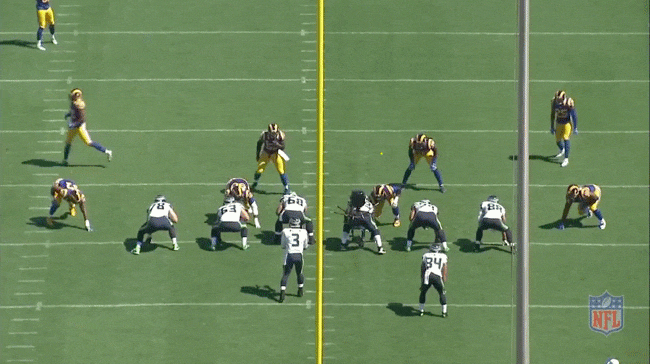
This is also a good example of the kind of impact a guy can have on the run game without actually crushing the stat sheet. Donald bursting through the line causes Wilson to pull the ball, but he has nowhere to go because DE Ethan Westbrooks stayed at home. Wilson gives himself up, but had Westbrooks cleaned up the play, Donald would have been the one to make it all happen.
2. Simple miscommunication.
Failing to execute blocks is one thing, but with so much flux and change along the line, the Seahawks are screwing up basic communication, too, and allowing entirely free defenders through virtually untouched. Here, the C and LG both think they’re just putting out a hand to help the other seat the block, and then go look for work elsewhere, but that means neither of them actually throws a meaningful block on DT Cam Thomas, who comes through the line quickly, only to trip and fail to make the play.
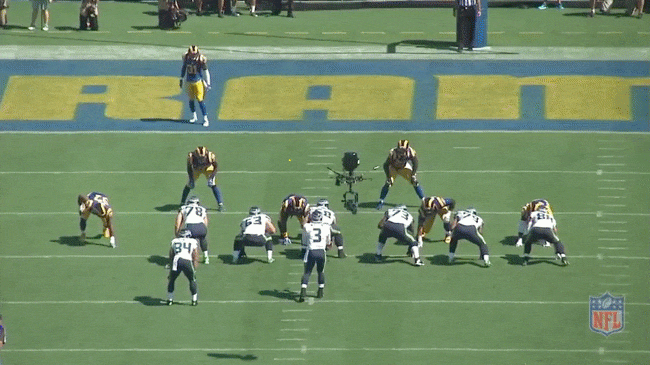
If this had been Donald, instead, Wilson would likely have been sacked right about the time he was finished checking his first read. The O-line is bad enough on an individual level that they simply can’t afford to give defenders additional free plays by screwing up assignments.
3. Just bad players.
Of course, even when they do get their assignments right and we’re only dealing with one-on-one blocks, the players themselves are just poor. Seattle expects to be able to insert linemen that have washed out at other franchises in the NFL and somehow raise their play through coaching, despite very limited live-action practice time these days, and it’s just not working.
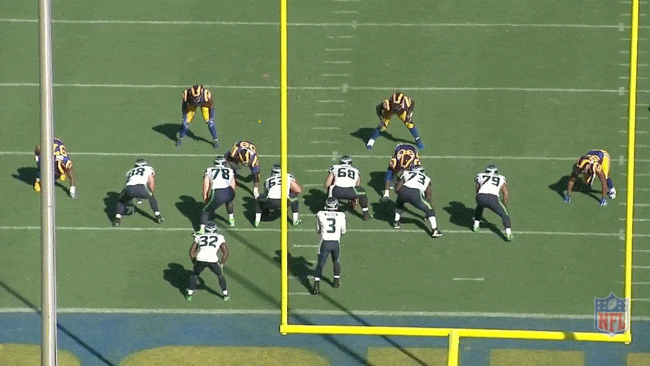
The game is littered with examples of players just getting whooped in one-on-one matchups and destroying plays. Every block except one can be perfect on a play, but if the one that breaks down is at the point of attack, the run is going nowhere. The same thing is true in pass protection. A clean pocket only exists if everybody holds up—as soon as one block fails, the play is in trouble, and we’re into free-styling things.
4. TEs can’t secure the backside.
Strictly speaking, this isn't on the offensive line, so the big guys can rest easy for a minute. One big problem the Seahawks have is that they can’t bolster the line with quality blocking from the TE position. I’m not even talking about keeping TEs in to pass block as a max-protect option in the passing game—I think you’re probably better off in today’s NFL flooding the field with receivers than you are flooding the line of scrimmage with pass protectors if you have a high-level QB. Instead, I mean this as a problem for the run game.
As we covered earlier, the Seahawks run almost nothing but zone, and many zone plays rely on the cutback option to create big gains and the most space. Against the Rams, the Seahawks' TEs weren’t able to secure the backside of run plays, resulting in RBs cutting back into a wall of Los Angeles defenders collapsing down the line and just smothering the life out of the play.

5. It’s breaking Russell Wilson.
This might be the biggest problem of them all. Issues Nos. 1–3 are starting to affect Wilson’s play. Ignoring the ankle injury, Wilson’s tape shows him beginning to throw passes in the act of flinching from pressure, rather than standing strong in the pocket and delivering while knowing contact may be coming. He’s also beginning to bail too quickly on entirely clean pockets in a way that was far more rare before. Wilson has never been a statuesque QB, and will take off and extend plays once the alarm in his head goes off, but now it’s happening more quickly.
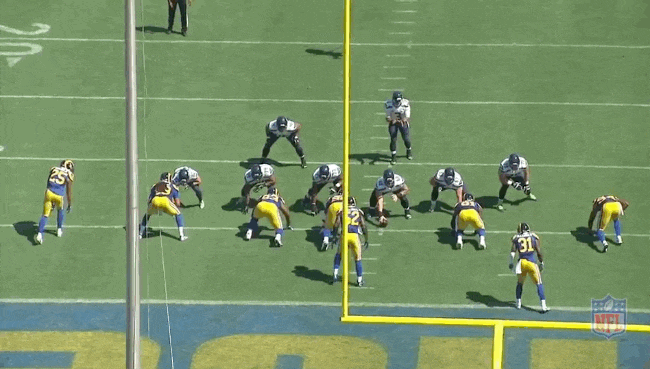
Sustained pressure can break a QB over a long period of time because it changes the fundamental nature of their game—the security they have in the pocket, the length of time they have to play with before they need to make something happen, and even potentially the scheme on offense (if they’re trying to cover it up). Russell Wilson is still playing well, and he is hampered at the moment with that ankle injury, but there are warning signs that the pressure from the line is beginning to affect him. That should be the biggest worry for the Seahawks right now, who have consciously avoided investing in the line because of Wilson’s ability to offset their play.
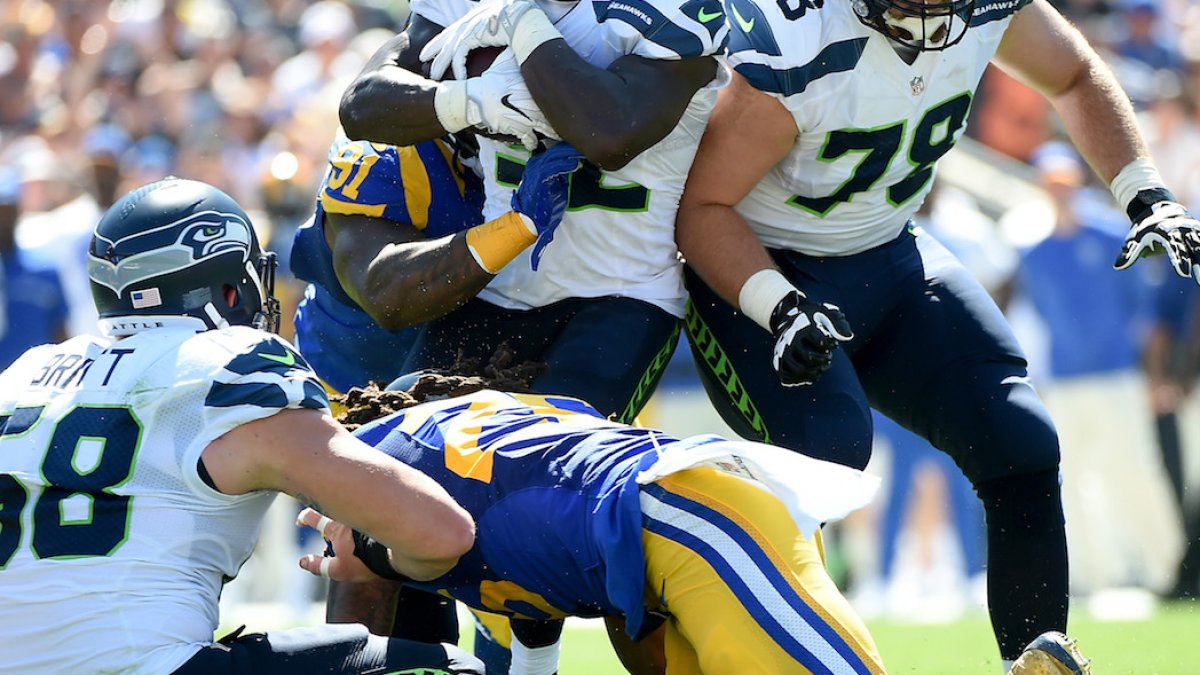


 © 2024 PFF - all rights reserved.
© 2024 PFF - all rights reserved.